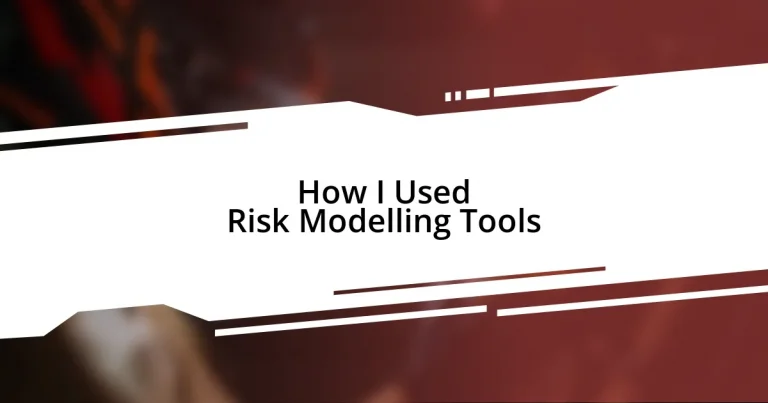Key takeaways:
- Risk modelling tools help visualize uncertainties and transform complex data into manageable patterns.
- There are various types of risk modelling tools, such as decision tree analysis and fault tree analysis, each serving different analytical purposes.
- Monte Carlo simulations allow users to input uncertain variables and explore a range of potential outcomes, aiding in informed decision-making.
- Visual representation of risk data is crucial for discovering insights and understanding risks beyond just numerical analysis.

Understanding risk modelling tools
Risk modelling tools are fascinating because they help visualize uncertainties in various projects. I remember the first time I used a risk modelling tool; it was like opening a new window into understanding potential pitfalls. Initially, I felt overwhelmed by the data, but soon I realized that these tools could transform complex information into manageable patterns.
One of the core aspects of risk modelling is the ability to assess potential outcomes based on variable inputs. Think about it—how often have you made decisions without fully understanding the risks involved? These tools empower you to factor in different scenarios and their probabilities, which I found invaluable when working on a particularly daunting project. I felt more confident when I could put numbers to my uncertainties.
I often reflect on the importance of visual representation in risk modelling. Whether it’s a Monte Carlo simulation or a simple risk matrix, seeing data laid out clearly can illuminate paths I hadn’t considered before. I often ask myself: how do I feel when I uncover insights that could drastically change my approach? The thrill of discovery keeps me engaged, reminding me that understanding risks isn’t just about numbers; it’s about making informed choices in the face of uncertainty.

Types of risk modelling tools
When I first encountered risk modelling tools, I realized there are several types, each tailored for different purposes. For instance, I found decision tree analysis particularly useful for visualizing choices and outcomes. It felt like mapping a journey, where each decision point could sway the final destination, making me reflect on the weight of each choice I had made in my projects.
Another tool I frequently used is the fault tree analysis (FTA). This method provides a reverse-engineering approach to identify potential failures and their causes. I distinctly remember working on a project where I traced back an unexpected cost to a seemingly minor oversight. That moment was a wake-up call—it made me appreciate how essential it is to dive deep and uncover the roots of issues before they snowball.
Lastly, I’ve had my fair share of experiences with Monte Carlo simulations. The first time I ran one, I felt a mix of excitement and anxiety. It’s incredible how this tool allows you to input various uncertain variables and see a simulated range of outcomes. Have you ever wished for a crystal ball to peek into possible futures? It’s not quite magic, but it does bring the unknown a little closer to home, helping to make more informed decisions.














